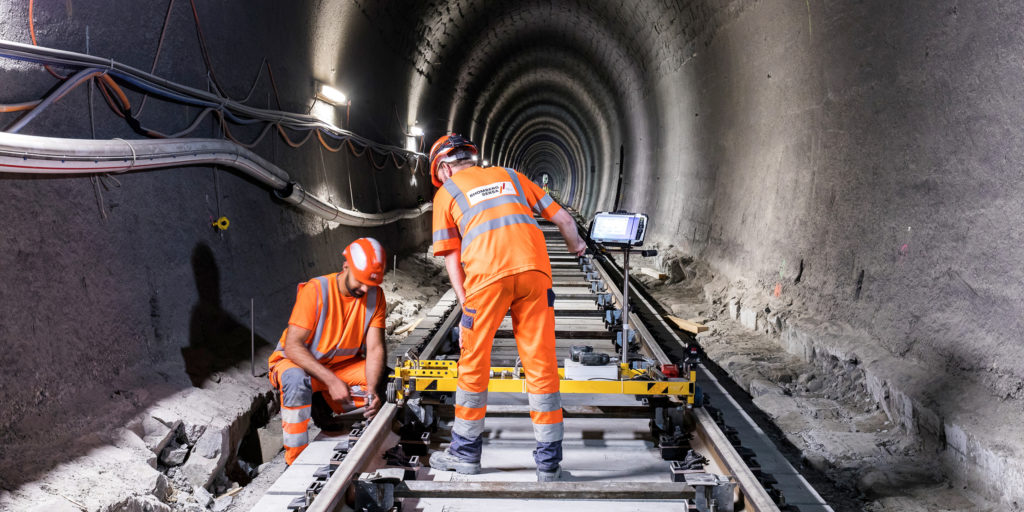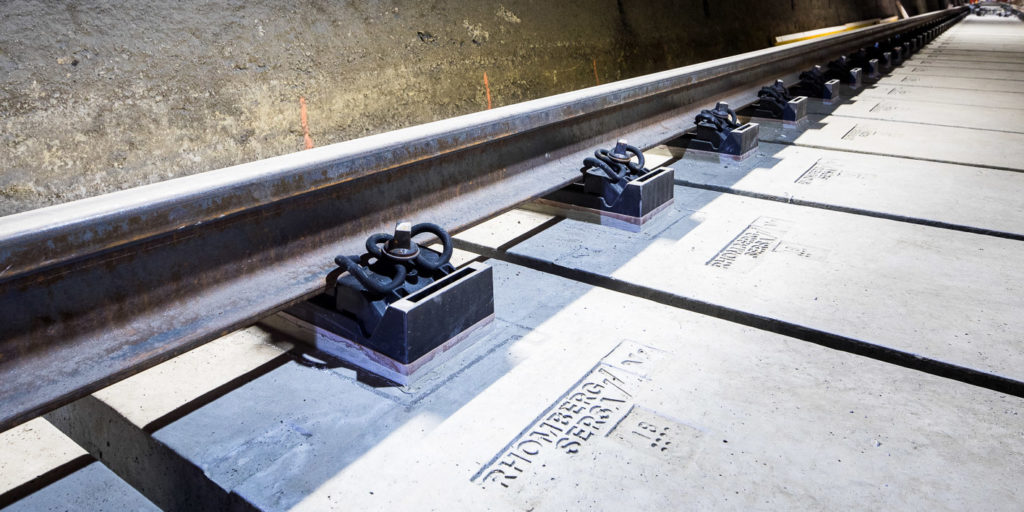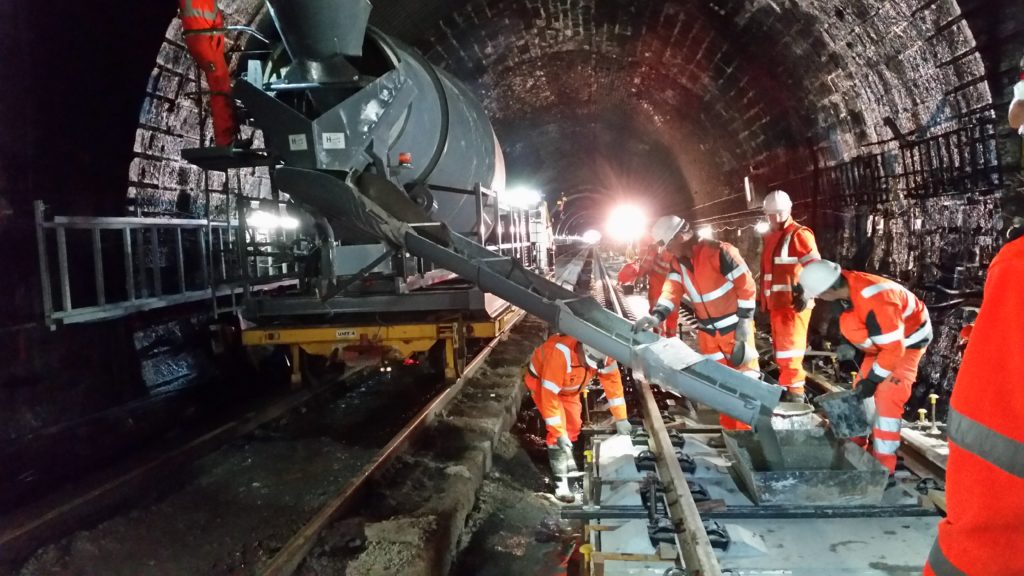Slab tracks, or, more properly, ballastless track systems, are becoming more widely used as alternatives to conventional ballasted track.
There are many reasons for this, but, to understand them properly, we need to consider the difference between the two forms of track design. In doing so, we shall attempt to keep the explanation as non-technical as possible, so we apologise in advance to those permanent way engineers who find our article too simplistic and lacking in detail. As always, Rail Engineer strives to find a happy medium.
Beauty of ballast
Conventional track, which uses ballast, can be seen all over the UK. While it is the ‘traditional’ way of supporting railway tracks, it isn’t as simple as it looks, and it is quite demanding in terms of maintenance. It certainly is a lot more than ‘the stones that help keep tracks safely in place’ or ‘the stones that form the track bed’, as Network Rail often describes ballast to try and help regional press understand why the local railway is shut.
Of course, ballast does consist of stones, but rather special ones. They have to be a certain size, around 25-50mm is considered to be best – one early track guide, published in 1868, suggests that “no bit of broken stone be used as ballast larger than a man could put in his mouth”.
They also need to have sharp, angular edges, so they will interlock to keep the track in place, and they have to be of hard material so they don’t grind themselves into dust due to the constant pounding from passing trains. Dust, and stones that are too small, will compact and stop the whole track system from draining properly.
When building a track, the first layer to go down is the bottom ballast. Laid 300-500mm thick, this is smoothed off and compacted to support the track’s sleepers. It can be laid very accurately using laser-guided bulldozers.
Actually, bottom ballast is often the second layer to go down. The first is a sheet of geotextile – in effect a ground sheet – that goes under everything. This textile is carefully designed to allow water to pass through, so the track will drain, but not to allow particles of dirt and mud back the other way. This prevents the vertical movement of the track caused by a train to ‘pump’ dirty water up from the subsoil or embankment, so contaminating the ballast.
Once the bottom ballast is laid, compacted and levelled, the track is then placed upon it. Finally, more ballast – the top ballast – is spread over everything and arranged so that the voids between the sleepers are filled, to stop the track moving fore and aft, and so that a pronounced hump or bank – the shoulder – is in place over the sleeper ends, to prevent the track moving sideways.

Well, that’s all the theory. In practice, trains make the track bounce up and down, compacting the bottom ballast still further in places and resulting in voids and an uneven track geometry. The stones rub together and start to wear away, creating dust and fine particles, and the whole track moves a bit to the left or right, or perhaps both.
The cure is to ‘tamp’ the track. Large machines lift the track clear of the bed, agitate the ballast under it, restoring volume where the ballast was compacted, and lay the track back down again. Again, these are laser controlled and very accurate – they are the same machines used to give the finishing touches to newly laid track so as to put it on an even level.

If the ballast has too many voids, a ‘stoneblower’ can be used instead, which does a similar job of temporarily raising the track but this time blows fresh new stone under it to fill those gaps.
Eventually, the whole ballast bed will need replacing – ballast can last around 20 years (depending on traffic) while the other track components can be double that. A ballast undercutter will raise the track, dig out the ballast, replace it with fresh and relay the track. Sometimes it even screens the old ballast, so good stones can be reused and only the bad ones are replaced.
A high-output ballast cleaner is immense. To replace one mile of ballast in one overnight shift needs a machine that is half a mile long (and includes 44 wagons to deliver new ballast and store extracted spoil) and costs £50 million. Plus, to get into those difficult areas such as in amongst points and crossings, another machine that looks like a giant vacuum cleaner is needed to suck the ballast out of the ground.
So, in short, ballasted track is more costly to lay than it looks, needs regular maintenance, which is also expensive, and has to be completely replaced every 20-40 years.

And we haven’t even discussed how wayward ballast stones get in the drains and clog them, how the draft from high-speed trains picks up the stones and throws them about, causing damage to both the train itself and the rails, and how sideways movement can reduce clearances between the track and lineside structures (or other tracks).
Alternative slabs
It’s now easier to understand why a solid track form, that can almost be forgotten once it is laid, could be so appealing.
There are two main types. One is cast in situ. A base layer, usually concrete, is laid over a prepared and compacted substrate. Sleepers are placed over this, though often they are just a pair of concrete blocks joined by steel rods to keep them the correct distance apart. Then the rails are laid on those blocks and clipped into place.
Finally, wet concrete is poured between the sleeper blocks. Once this is set, the track is essentially one homogeneous mass. It won’t move anywhere, anytime soon.
This type of system is currently being used on the West Midlands Metro extension in Birmingham.
A more advanced system is to form the track slab from individual precast panels. These are manufactured offsite and are then installed and aligned on a prepared sub-surface, again usually concrete. They can be positioned very accurately and adjusted using jacking screws in the corners of the slabs. Once in place, they are secured by having grout (another form of concrete) pumped underneath them both to spread the load away from the jacking screws and to fix them in place.
The advantages over a cast-in-situ system are that the slabs can be manufactured and positioned with great accuracy, they can be laid piecemeal so gaps can be left where infrastructure works still need to be completed, the rails don’t need to even be present when the slabs are installed, and they can be replaced individually if damaged.
The downside is they are more expensive to install than both cast-in-situ and ballasted track, but a lot cheaper to maintain.
When installed in tunnels, both types of slab track can be laid with a resilient layer between the slab and the concrete tunnel lining. This prevents the transfer of noise and vibrations from the track slab into the tunnel structure and so to the ground above. For this reason, the track in the Crossrail tunnels consists largely of one of four types of resilient track, depending on the location.

In-house innovation
All of these systems need experienced installers and maintainers to get the best out of them. New railway construction could use two, or even all three, types of track along its length, so the installer has to be versatile.
Rhomberg Sersa has been building slab-track railways since the 1970s and has developed a well-grounded technical expertise across all the various slab track systems and alternatives. The company has even used this experience to develop its own IVES ballastless track system, which is both cost effective and easy to install in confined spaces.
IVES, which stands for intelligent, versatile, efficient and solid, uses a narrow pre-manufactured slab, looking more like a traditional railway sleeper than the larger slabs used in most other systems.

The sub-surface layer is usually asphalt, laid as a conventional roadway and finished using road-roller technology. The rectangular slabs are placed across the line of the finished track, evenly spaced. The whole track is then assembled and rails fastened into the clips on each ‘sleeper’, largely by hand in areas where heavy machinery would find access difficult. At this stage, the tracks themselves can now be used to access the rest of the worksite.
When everything is finished, the final adjustments are made and everything is grouted into place. A few hours later, and the line can open for traffic.
Rhomberg Sersa also turned its attention to where conventional ballasted track transitions into slab track – perhaps at a tunnel portal or at the start of a bridge deck. Here, the difference in track fixity means that the settlement of ballast stones at the interface results in voids or hanging sleepers in the track adjoining the slab track or bridge, giving rise to higher forces and damage as trains traverse the ‘dip’.
The solution is V-TRAS, a steel cantilever on which the first few sleepers of the ballasted track sit, giving them additional support thereby providing the rail with additional support and spreading the impact of any potential dip to counter the differential settlement.
New Bailey Street bridge
Both innovations were used back in 2017, when the Rhomberg Sersa Rail Group was contracted to develop a low height, low weight slab solution for New Bailey Street bridge deck/track replacement as part of the Northern Hub project.
For the bridge itself, a plinth variant of the IVES slab-track system was selected but, due to the design requirements of the new bridge, a completely new method of fixing was developed that allowed for plinth removal/replacement in the future.

Each plinth unit had four, specially designed spindles and anchors to secure it that sat within core-drilled apertures in the bridge deck – precisely located to match the plinth geometry. Once positioned, the plinths were then lifted to height using the spindles, shuttered, and a high-specification grout poured through the plinths to fill the voids under them, surrounding the spindles and anchors.
This design allows for the fast and effective removal/replacement of any single plinth, if that should ever be required.
Once the rail was in its final design position, and an accuracy of ±1mm was achieved, grout was poured to stabilise and fix the baseplates.
A V-TRAS cantilever system was fitted to create the ballast-to-slab transition.
Winchburgh tunnel
In 2015, as part of EGIP electrification, Winchburgh tunnel, just east of Linlithgow on the route out of Edinburgh Waverley station, required track lowering up to 200 mm and the installation of slab track at a cost of £17 million. This was an essential element of the Edinburgh to Glasgow electrification programme, which was set to transform train services across Scotland’s central belt.
The tunnel is 388 metres long and has a pointed roof profile. Lowering the track by up to 200mm, together with the use of a Furrer+Frey rigid overhead conductor rail system (ROCS), would just be sufficient to provide the required electrification clearance. To ensure this clearance was maintained, the track had to be fixed in position, requiring the installation of slab track. This would significantly reduce track maintenance and increase speed through the tunnel from 80 to 90 mph.
Principal contractor Morgan Sindall chose the ÖBB-PORR ‘Slab Track Austria’ system – the first time that it had been used on the UK rail network, although it had already been trialled on the Old Dalby test track in Asfordby tunnel.

The system was jointly developed by Austrian Railways (ÖBB) and concrete construction specialist Porr, based in Vienna. It was first used in 1989, has been Austria’s standard slab track system since 1995, and has also been widely used in Germany since 2001, where the Erfurt to Leipzig high-speed line used 180km of it.
The principal element of the system is a 160mm thick concrete slab that has up to eight pairs of track fastenings. There are different geometries for straight track and different curves. The slabs are fixed to a foundation layer using self-compacting concrete (SCC) that is poured through rectangular tapered openings in the base plate after it has been accurately positioned using the five jacking screws in the slab.
The pre-cast slab incorporates an elastic rubber coating which absorbs vibration. This coating also serves as a barrier between the slab and the SCC, enabling it to be easily broken out in the unlikely event that it should need to be replaced.
Rhomberg Sersa had installed the Slab Track Austria system in Asfordby tunnel for the trial and was now contracted to install the 188 five-metre slabs in Winchburgh tunnel during a 44-day blockade.
The concrete base slab was poured by Babcock, after which it took Rhomberg Sersa two days to accurately position all the slabs on one line. When there were sufficient slabs in place, 110-metre-long rails were fitted on them to ensure accurate positioning.
Watertight formwork was needed as the SCC is very fluid. After the SCC pour, it took 24 hours before the track could carry traffic. The slab track was then complete, and the process was ready to be repeated for the down line.
Queen Street tunnel
One year later, and attention switched to the Queen Street tunnel. Much longer than Winchburgh, at 1159 yards, the twin-track tunnel already had slab track, fitted in the 1970s in a bid to reduce maintenance costs. However, it had deteriorated badly after 40 years of use, so, with the need to both replace 1.8 kilometres of tunnel slab track and undertake station throat works, a lengthy closure of Scotland’s third-busiest station was inevitable.
On 20 March 2016, Queen Street High Level station was closed for twenty weeks. During this time, a comprehensive plan ensured that passengers could get to Glasgow, albeit with extended journey times. Trains were diverted to the Low Level station or the city’s Central station, additional use was made of the line via Airdrie and Bathgate and extra local buses were provided for travel to local stations.

Rhomberg Sersa was contracted to install a Slab Track Austria (STA) plain-line slab system, as well as a Sonneville LVT slab system for the switches and crossings (S&C) within the tunnel.
Unlike Winchburgh, the Queen Street work required the removal of the previous slab track. A trial breakout had been undertaken during the previous December, to confirm the proposed methodology. This removed 20 metres of the tunnel slab track, which was then temporarily replaced with ballasted track.
Once the blockade started, tunnel, lighting, ventilation and communication systems were installed and a coring machine was used to prepare the slab track for its removal. Story Contracting was responsible for the removal of the old slab track, constructing a concrete base layer for the new slab track and installing a new drainage system between the Up and Down base slabs. Due to the restricted access, the concrete for the base slabs had to be supplied through the two original tunnel construction shafts.
The base slabs were completed by 19 May, and Rhomberg Sersa began installing the 5.2-metre-long, 160mm thick STA slabs on the Up line. This was completed by 3 June, work moved on to the Down line and the whole station reopened on 7 August as planned.

Further work
Since those two major projects in Scotland, Rhomberg Sersa has installed a number of sections of slab track around the network. On the Gospel Oak to Barking line, three sections of slab track were installed under bridges and more in the tunnel at Crouch Hill, totalling approximately 1,400 track metres. Twelve V-TRAS transition units, one at each interface between the slab and ballast, were also fitted.
Most recently, Rhomberg Sersa is fitting slab track inside Gasworks tunnel at London King’s Cross, bringing a third bore of that tunnel back into use to expand capacity at the London terminus.
Slab track isn’t the only option for modern railways and ballasted track will be around for many years to come – probably for ever. Rhomberg Sersa certainly hopes so, it also has a good business replacing conventional track through stations and in hard-to-reach places using its innovative Machine Group ballast removal and delivery train.
However, slab track is definitely the way to go in some applications. For high-speed railways, in tunnels with tight clearances, on bridges where weight and access for maintenance are issues – all of these are ideal applications for slab track.

As we have shown, there are several forms of slab track as well – they, too, have their particular applications.
The common thread is Rhomberg Sersa. Whichever form of slab track is chosen, the installer needs the experience to do the job properly, safely and on time. And if that installer can also ‘tweak’ the design where needed, or come up with its own solutions, then so much the better.
Thanks to various Rail Engineer colleagues whose words of wisdom have been shamelessly ‘borrowed’ for parts of this article.

